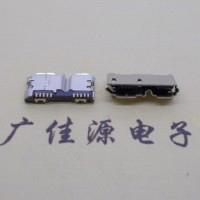micro usb3.0 interface dual socket 10p definition pin soldering details, Micro USB is a portable version of the USB 3.0 standard, part of the cell phone using the MICRO USB interface is smaller, Micro-USB is the next generation of Mini-USB specifications, Micro-USB support for OTG, and the same as the Mini-USB, but also the 5pin.The Micro series is defined by the Micro-B series of slots used by standard devices; the Micro-AB slots used by OTG devices; Micro-A and Micro-B plugs, and cables.The Micro series is unique in that they include stainless steel housings, and 10,000 plugs and pulls are not a problem. From 2017 the EU will fully harmonize the use of MicroUSB port chargers.USB who have seen and used, as one of the most common interfaces in the world, USB has long been into our lives. So what is the interface definition of USB? Let me briefly analyze it. Because USB3.0 including USB2.0 pins, USB3.1 and 3.0 pins are the same, so this article micro USB3.0 (i.e., USB3.1 Gen1) as an example to explain. First of all, the first 4 roots, that is, backward compatible USB2.0 part. Because USB2.0 transmits a half-duplex differential signal, so transferring data requires at least 3 wires - D+/D-/ground (upstream and downstream share two data wires), plus the positive power supply of the red wire, a total of 4 roots.
It's the 5 after that are the USB3.0 high-speed data transfer lines. Because Micro USB3.0 transmits full-duplex differential signals, it requires two pairs of data lines and a shielded ground. As you can see, MicroUSB3.0 for backward compatibility, the MICRO USB3.0 part of the complete retention of another 10 wires for full-duplex high-speed transmission, although the cost is higher, but to a certain extent to avoid the impact of the problem of the quality of the wire.
Now MICRO USB3.0 is still in popularity, there is no need to force the USB3.2 and Thunderbolt this almost no one used than a high and low, after all, the demand for high-speed interface USB3.0 can also basically meet the needs of the 3.0 speed of 5GT/s, 3.1 is 10GT/s, can be interpreted as a doubling of the transmission speed, but the actual speed on the double, because the coding method of the Replacement, the actual effective speed more than doubled.Type-C It should be noted that Type-C is only a kind of interface, and the version of USB does not have anything to do with it, just like most of the cell phones now have Type-C or 2.0. But the 3.1 micro-interface solution is generally Type-C, and certain places with plenty of space also use Type-C to show their advancement, the











